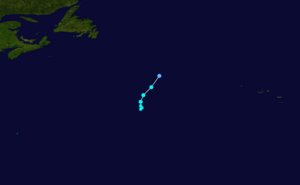Tropical Storm Jerry (2007) facts for kids
| Tropical storm (SSHWS/NWS) | |

Tropical Storm Jerry over the north-central Atlantic.
|
|
| Formed | September 22, 2007 |
|---|---|
| Dissipated | September 24, 2007 |
| Highest winds | 1-minute sustained: 40 mph (65 km/h) |
| Lowest pressure | 1003 mbar (hPa); 29.62 inHg |
| Damage | None |
| Areas affected | No land areas |
| Part of the 2007 Atlantic hurricane season | |
Tropical Storm Jerry was the tenth named storm of the 2007 Atlantic hurricane season. This storm was very short-lived. It formed over the central part of the Atlantic Ocean. Jerry lasted less than 48 hours in total. For half of that time, it was a subtropical cyclone. The storm never came close to land.
Contents
How Tropical Storm Jerry Formed
The weather system that became Tropical Storm Jerry started on September 21. It was a non-tropical low pressure area over the central Atlantic Ocean. Over the next two days, this system moved in a wobbly path. It slowly grew stronger. The system developed deeper convection, which means more thunderstorms. It also became more organized.
On September 22, the system was organized enough. The National Hurricane Center thought it might become a tropical or subtropical storm. Later that evening, a subtropical depression had formed. This means it had a warm center. However, it was still connected to a high-level low pressure system. Its strongest winds were far from the center.
Jerry Becomes a Subtropical Storm
Early on September 23, data from satellites and QuikScat showed something new. The depression had become Subtropical Storm Jerry. This happened even though it did not have a clear inner core.
The storm slowly gained more tropical features. Its warm center became better defined. By that evening, it had fully turned into a tropical storm. It was a weak tropical storm with winds of 40 mph (65 km/h). These winds were over a small area.
Jerry Weakens and Disappears
Jerry started to weaken again on September 24. It moved faster towards the northeast. It went over cooler waters. The sea surface temperatures were below 24°C (75°F). It stayed a tropical storm until later that morning.
Then, it weakened into a tropical depression. A strong cold front was approaching. There were very few thunderstorms left in the system. Jerry remained a tropical depression as the cold front got closer. The front began to absorb the storm that afternoon. Jerry continued to speed up towards the northeast.
That evening, a QuikScat pass showed that Jerry had opened up. It became a trough, which is like a long, narrow area of low pressure. This trough was being absorbed into the larger frontal system. Tropical Storm Jerry completely disappeared by early on September 25.
What Was the Impact of Tropical Storm Jerry?
Tropical Storm Jerry never got close to land. Because of this, no damage was reported. No one was hurt or died because of the storm. Also, no ships were affected by Jerry during its short life.
More About Hurricanes
- 2007 Atlantic hurricane season
- You can find the National Hurricane Center's archive on Tropical Storm Jerry here.


